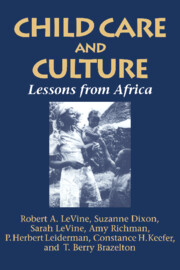Book contents
- Frontmatter
- Contents
- List of tables and figures
- Foreword
- Acknowledgments
- Introduction
- Part I African infancy: Frameworks for understanding
- Part II Parenthood among the Gusii of Kenya
- 3 Gusii culture: A person-centered perspective
- 4 Gusii fertility, marriage, and family
- 5 Pregnancy and birth
- Part III Infant care and development in a Gusii community
- Part IV Interpretations
- Appendix A Fieldwork procedures: Initial phases and planning
- Appendix B Coding categories for spot observations
- Appendix C Blankhart Nutrition Questionnaire
- Appendix D Temperament Assessment Method
- Appendix E Coding categories for narrative observations
- Appendix F Coding categories for face-to-face interaction
- Appendix G Coding categories for maternal teaching task
- Appendix H Supplementary tables
- Notes
- References
- Index
- Plate section
4 - Gusii fertility, marriage, and family
from Part II - Parenthood among the Gusii of Kenya
Published online by Cambridge University Press: 11 May 2010
- Frontmatter
- Contents
- List of tables and figures
- Foreword
- Acknowledgments
- Introduction
- Part I African infancy: Frameworks for understanding
- Part II Parenthood among the Gusii of Kenya
- 3 Gusii culture: A person-centered perspective
- 4 Gusii fertility, marriage, and family
- 5 Pregnancy and birth
- Part III Infant care and development in a Gusii community
- Part IV Interpretations
- Appendix A Fieldwork procedures: Initial phases and planning
- Appendix B Coding categories for spot observations
- Appendix C Blankhart Nutrition Questionnaire
- Appendix D Temperament Assessment Method
- Appendix E Coding categories for narrative observations
- Appendix F Coding categories for face-to-face interaction
- Appendix G Coding categories for maternal teaching task
- Appendix H Supplementary tables
- Notes
- References
- Index
- Plate section
Summary
For Gusii infants and their parents, high fertility is a pervasive condition of family life and child development. Like parents elsewhere in Africa, the Gusii fervently desire the maximum number of surviving offspring, but they have been exceptionally successful in achieving this goal: Their fertility ranks near the top among human populations. The population of Kisii District, that is, Gusiiland, grew from under 300,000 in 1948 to well over a million in 1979, with the highest population growth rate in Kenya (which has the highest national growth rate in the world) and it also became, as of the 1979 census, the most densely populated district in the country. Thus fertility, though highly valued by the Gusii, had resulted in a serious ecological problem by the last quarter of the 20th century.
This situation was evident in Morongo, where the 1956 population density of 450 per square mile had risen to about 1,000 by 1976. Robert LeVine, who lived at Morongo in the 1950s, was unable to recognize the Nyansongo locality in 1974 because of the number of houses filling up the cow pastures, which had been its most visible internal boundaries. Homesteads, and houses within homesteads, were closer together than they had been – too close for comfort, by Gusii standards.
Ombese, a 60-year-old father in our sample, exemplifies the consequences of population growth for family life. His father, one of the original settlers of Morongo, had owned a large hillside of 75 acres, and Ombese, as one of three sons, had inherited about 20 acres.
- Type
- Chapter
- Information
- Child Care and CultureLessons from Africa, pp. 92 - 120Publisher: Cambridge University PressPrint publication year: 1994
- 2
- Cited by



